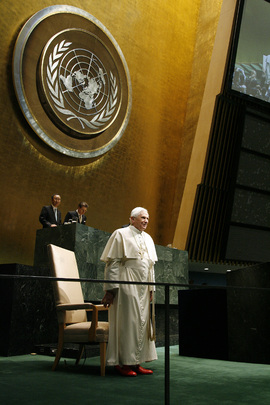
By Otto Spijkers
Whenever someone embraces the responsibility to protect at the UN General Assembly, I think it is worth mentioning. Yesterday it was the Pope who embraced that concept. Even though it may seem a modern idea, this ‘responsibility to protect’, it has in fact always been with the United Nations in some form, although it hasn’t always been as popular as it is presently. In this post, I will give a very brief overview of the most important formulations of this principle in the period between 1944 and today. At the United Nations Conference in San Francisco, in 1945, it was suggested to add a principle to the UN Charter that somehow described the following idea:
It is the duty of each member of the Organization to see to it that conditions prevailing within its jurisdiction do not endanger international peace and security and, to this end, to respect the human rights and fundamental freedoms of all its people and to govern in accordance with the principles of humanity and justice. Subject to the performance of this duty the Organization should refrain from intervention in the internal affairs of any of its members.
This suggestion is very similar to Principle 2 of the Principles for the International Law of the Future, published in the American Journal of International Law, Vol. 38, No. 2, Apr., 1944 (Supplement: Official Documents):
Each State has a legal duty to see that conditions prevailing within its own territory do not menace international peace and order, and to this end it must treat its own population in a way which will not violate the dictates of humanity and justice or shock the conscience of mankind.
See also the interesting commentary which was published together with the Principle. But unfortunately such a principle never made it into the list of principles of the UN Charter. In December 2001, the International Commission on Intervention and State Sovereignty published a report , introducing the responsibility to protect. The concept can be defined by the following two basic principles:
1. State sovereignty implies responsibility, and the primary responsibility for the protection of its people lies with the state itself. 2. Where a population is suffering serious harm, as a result of internal war, insurgency, repression or state failure, and the state in question is unwilling or unable to halt or avert it, the principle of non-intervention yields to the international responsibility to protect.
This concept was embraced by all 192 member states of the United Nations in 2005, in the World Summit Outcome Document:
Responsibility to protect populations from genocide, war crimes, ethnic cleansing and crimes against humanity 138. Each individual State has the responsibility to protect its populations from genocide, war crimes, ethnic cleansing and crimes against humanity. This responsibility entails the prevention of such crimes, including their incitement, through appropriate and necessary means. We accept that responsibility and will act in accordance with it. The international community should, as appropriate, encourage and help States to exercise this responsibility and support the United Nations in establishing an early warning capability. 139. The international community, through the United Nations, also has the responsibility to use appropriate diplomatic, humanitarian and other peaceful means, in accordance with Chapters VI and VIII of the Charter, to help to protect populations from genocide, war crimes, ethnic cleansing and crimes against humanity. In this context, we are prepared to take collective action, in a timely and decisive manner, through the Security Council, in accordance with the Charter, including Chapter VII, on a case-by-case basis and in cooperation with relevant regional organizations as appropriate, should peaceful means be inadequate and national authorities are manifestly failing to protect their populations from genocide, war crimes, ethnic cleansing and crimes against humanity.
And now the Pope’s words can be added to the list of various formulations of the responsibility to protect. These are the words of the Pope:
Recognition of the unity of the human family, and attention to the innate dignity of every man and woman, today find renewed emphasis in the principle of the responsibility to protect. This has only recently been defined, but it was already present implicitly at the origins of the United Nations, and is now increasingly characteristic of its activity. Every State has the primary duty to protect its own population from grave and sustained violations of human rights, as well as from the consequences of humanitarian crises, whether natural or man-made. If States are unable to guarantee such protection, the international community must intervene with the juridical means provided in the United Nations Charter and in other international instruments. The action of the international community and its institutions, provided that it respects the principles undergirding the international order, should never be interpreted as an unwarranted imposition or a limitation of sovereignty. On the contrary, it is indifference or failure to intervene that do the real damage. What is needed is a deeper search for ways of pre-empting and managing conflicts by exploring every possible diplomatic avenue, and giving attention and encouragement to even the faintest sign of dialogue or desire for reconciliation.

It is interesting to see that the same story appears on many many other blogs, all with more or less the same argument, i.e. that it is important that someone with authority, in casu the Pope, embraces the responsibility to protect. See for example, here, here, here, here, and here.
I personally think the more people write about it the better, but I guess the relevance of the post depends on the blog’s authority, and whoever came first. And, of course, there must be people left in this world to actually do the reading, as opposed to the writing, of all these posts.